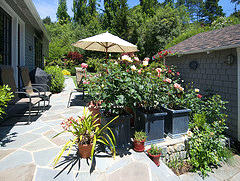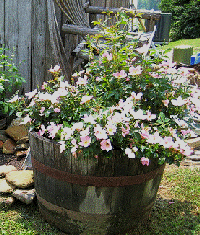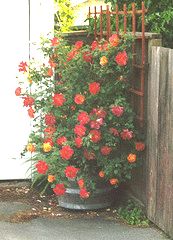Growing Roses in Containers
You can grow just about any roses in containers, window boxes and hanging baskets.
Just about any rose can be grown long term in containers. There are roses ideally suited to containers, including miniature roses and polyanthas. Even shrub roses, rose standards, and small climbers can thrive in containers. But the care you give and even the container you select will be very important to success.
Sun
Potted roses are often used for patios, balconies or entryways, so make sure your roses receive a minimum of 6 hours of sun. More sun is even better, but the sun can also heat up your container. Planted in the ground roots are kept cool. In warm climates, if your potted rose will receive a lot of sun, be cautious about the container you select and keep up with the watering. The larger the container, the more soil you will have to keep the roots cooler. Some rose varieties do better than others with only six hours of sun, so check the requirements for your selected rose. Generally, the more petals a rose has, the more sun it will require to produce consistent blooming and large blooms.
Rose Selection
The mature size of your selection will be important in choosing a container. A large shrub rose will require a huge container to maintain a healthy rose. Many shrub roses respond well to shearing and severe pruning each year, which can help keep the shrub an appropriate size for your space and container. Miniature roses and small Polyantha roses are excellent for smaller containers, window boxes or hanging baskets. Polyantha roses and floribunda roses are generally a good size for larger containers. Most of the shrub roses will require a very generous container.
A continuous blooming or repeat blooming rose will keep your container looking good. You may also want to select a rose that blooms on new wood if you expect to see much blooming in the first season. If you select once blooming roses, you can certainly include other plants in your container. Choose long blooming perennials or annuals that will give you color all season. Also make sure your container is large enough to support the additional plants.
Container Selection
Your roses will want plenty of soil for rooting space, and a lot of soil will hold a lot of water that your roses will also want. So you must have a container large enough for the size of your rose. Err on the generous size so the soil does not dry out too quickly.
Miniature roses and probably the small polyantha roses will do fine in a 5 gallon container. To give you an idea of the actual size, a 12 inch deep container that is 11 inches across will hold 5 gallons.
Smaller floribundas, and many polyantha roses will be happy in a 10 gallon container. A 16 inch deep container that is 14 inches across will hold ten gallons. (Your medium garbage container under the kitchen sink is only 8 gallons, it should be bigger than that for your roses.)
Hybrid tea roses, large floribunda roses, grandiflora roses and small to medium sized shrub roses will need a 15 gallon container. A 17 inch deep container that is 15 inches across will hold 15 gallons. (Your tall kitchen garbage container in the closet is only 13 gallons, it should be larger than that for these roses.)
Large shrub roses (up to 5’ high and wide) and climbers will need 20 to 30 gallon containers. Something along the lines of a whiskey barrel should be about 30 gallons.
Clay planters are ideal for keeping your roots cooler in hot weather, but they are substantially heavier than the lightweight plastic and resin containers. A 10 gallon planter is difficult too move if it is clay or pottery. Clay and pottery pots can also crack in freezing temperatures. Fortunately the new plastic planters are looking pretty good, some are hard to distinguish from pottery from any distance. Choose a light to medium color, the darker color plastics heat up, drying out your soil and heating the roots too much. Moving 15 to 30 gallon containers of any material will require 2 people, or place it on a base with wheels. In cold climates you may be moving your containers into a shed, garage or in a sheltered corner to winterize the rose.
Make sure, of course, that your pot has drainage holes. No need to “fill” the bottom with gravel, styrofoam peanuts or any other “drainage” material. That’s what the holes are for, and your filler will take valuable soils space away from your rose. The larger the pot, the more holes that are needed. Four holes at least for a 20 gallon pot, up to eight for a 30 gallon pot. Whiskey and oak wine barrels will often have drainage holes, but will often “weep” also. Side holes are best, if your holes are on the bottom you might want to raise the pot a bit with shims so the excess water can drain away easier. The only reason to put anything in the bottom of your container is to add weight to keep a tall plant, a climber on a pillar for example, from blowing over. Use an inch of builders sand if you are concerned about a windy location.
Soil
Never use garden soil in your planters. Garden soil, or top soil, is very heavy, compacts easily and does not drain well. Use a good quality potting soil. Or mix your own with one third potting soil, one third aged compost, and one third composted manure. Add one cup perlite to improve drainage. You may also want to add to your purchased or mixed soil one cup of bone meal. Blood meal or fishmeal may be added to increase nutrients.
You should replace the soil every three years or so. Roses are very heavy feeders and will deplete the soil nutrients, fertilizer will not make up the difference. They may also be a build up of soluble salts from the fertilizer after a few years. This is also a good time to root prune if the plant is becoming root bound. Simply trim back the roots, new ones will be replaced quickly.
Planting a Rose in a Container
When planting a rose in a container, the bud union should be at or just above the soil line. The rose will grow more vigorously if the bud union is not below the soil line. If you plan to overwinter your rose outside in a cold climate, the bud union should be just below the soil line.
Fill the container about two thirds with prepared soil. Create a soil mound in the center and place the rose over it, spreading the roots out carefully. Fill with more soil and tamp the soil by pressing firmly, but gently with flat hands around the roots. Continue filling the container and tamp lightly until the soil has reached the desired level of the bud union. Ideally when you finish the soil will be fully to the top of the pot. The soil will settle substantially with the first watering, and will continue to settle over time. Cover the soil with spanish moss or other mulching material to prevent soil splash when you water. Now completely saturate the soil until water runs from the drainage holes. Use a light flow so as not to displace the mulch and create deep depressions in the soil. The soil should be saturated slowly.
Water and Fertilizer
Regular watering and fertilizing will be critical to the health of your rose. Insufficient watering or over watering will also result in inferior blooms. Soil that dries out and becomes overheated (a dark colored plastic pot will accelerate the heating of the soil) will also result in inferior blooms.
Expect to water your container every week, saturating the soil until water runs from the drainage holes. Watering should be adjusted according to weather conditions. Poke your finger into the soil about an inch. If it feels dry, water. If it is still moist, do not water yet. Fertilize every week with a water soluble fertilizer mixed at one fourth the recommended strength. It is very easy to “burn” container plants with heavy doses of fertilizer. In the ground, there is a lot of soil to dilute heavy fertilizations.









